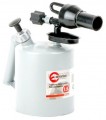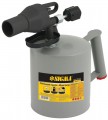Fuel type
The type of fuel for which the device is normally designed.
This parameter is relevant for models using flame heating (in devices operating with an electric arc, fuel is not used as such).
—
Propane-butane. Gaseous fuel in the form of a mixture of pressurized light hydrocarbons, primarily propane (C3H8) and butane/isobutane (C4H10), hence the name. Such a mixture is not only easier to obtain than relatively pure propane or butane — it also has a higher flame temperature (2400 – 2700 °C versus 2100 – 2500 °C).
—
Propane. Gas fuel based on propane. The share of the latter should be at least 75% (depending on the specific brand of fuel). Propane (C3H8) is one of the lighter saturated hydrocarbons; it lends itself well to liquefaction and transportation in cylinders, however, it gives a lower flame temperature than the propane-butane mixture (see the relevant paragraph) — 2100 – 2500 °C versus 2400 – 2700 °C.
—
Bhutan. Gas fuel based on butane (containing at least 60% butane by mass). From the point of view of operational characteristics, butane practically does not differ from the propane described above
—
Acetylene. Gas fuel based on acetylene (C2H2). Acetylene is considered a "classic of the genre" in gas welding and cutting — primarily due to the high flame temperature (3100 – 3600 °C), which all
...ows it to be used for any gas-flame work.
— Methane. Gas fuel based on methane (CH4). Methane is very common and easy to obtain — in particular, it is the main component of natural gas. However, the flame temperature of this fuel is low — 2000 – 2200 °C, which limits its use in welding: only relatively low-melting materials can be cooked with methane. In addition, methane has a rather low calorific value; it is consumed many times faster than the same propane-butane.
— MAF. Gas fuel based on MAF — the so-called. methylacetylene-allene fraction (plus about 25% propane for stabilization). In terms of combustion characteristics, it is similar to acetylene (see the relevant paragraph), it gives a slightly lower flame temperature (from 2900 °C), but has a higher calorific value. At the same time, MAF costs 2-3 times cheaper, compresses better and does not require fillers for storage in cylinders, due to which almost four times more MAF can fit into one standard cylinder than acetylene — 21 kg versus 5.5 kg, with the same total weight containers.
— MAPP. Gas fuel based on MAPP — the so-called. methylacetylene-propadiene fraction. According to the characteristics and features, similar to the MAF described above, it is also used as a substitute for acetylene. Moreover, this type of fuel can be used at higher pressures than acetylene, which is convenient, in particular, for underwater cutting. On the other hand, the MAPP flame contains a higher concentration of hydrogen, which is why it is not suitable for welding large steel parts (although this moment is not critical for small amounts of work).
— Coke oven gas. Fuel based on coke oven gas — a gas obtained by coking coal. Due to its simplicity in production, it is inexpensive, but it gives a relatively low combustion temperature (up to 2300 °C), so that only low-melting materials can be cooked with such fuel. However, this is quite enough for oxygen cutting.
— Universal (gas). This marking means that the burner can work with different types of gas fuel. However, the set of compatible fuel types may be different, it should be specified separately.
— Gasoline. The most popular type of blowtorch fuel; however, it can also be used in cutters (see "Type"). Gasoline evaporates easily, which facilitates its use in such devices, and has the highest combustion temperature among all popular liquid fuels — about 1300 – 1400 °C in atmospheric air. In addition, the advantages of this type of fuel include availability: you can buy gasoline at a hardware store or at a gas station.
— Kerosene. Another popular type of liquid fuel, along with gasoline (see related paragraph). Gives a relatively low flame temperature — up to 800 °C; however, in pure oxygen, this figure can reach 2000 °C. At the same time, we note that very few purely kerosene heaters are produced: since such fuel is very similar to gasoline in physical properties, combined devices that can run on both gasoline and kerosene are more popular.
— Diesel. Liquid fuel, colloquially referred to as diesel fuel. It gives a lower flame temperature than gasoline — about 1100 °C — and evaporates worse, which makes it difficult to use in blowtorches. On the other hand, diesel is more economical: firstly, it generates more thermal energy during combustion, which reduces consumption, and secondly, it costs less than gasoline.Max. temperature
The maximum temperature of the flame produced by the heater. Note that this indicator may be lower than the theoretical fuel combustion temperature — this is due to the physical features of the process.
In general, the more heat-resistant the material you plan to work with, the higher the flame temperature should be. Also, the required temperature may vary for different types of work: for example, oxyfuel cutting does not require as much heat as welding. Detailed recommendations regarding the optimal temperature for different tasks and materials can be found in special sources.
Max. oxygen pressure
The maximum pressure of oxygen or compressed air for which the device is designed.
This parameter is required for safe connection to an oxygen/air source: the maximum allowable pressure must not be exceeded in order to avoid accidents.
Tank volume
The volume of its own fuel tank provided in the device (if such a tank is available in the design, many models operate from external cylinders).
A large tank allows you to work longer without refueling, all other things being equal; it is especially important for powerful high consumption instruments. On the other hand, with a small tank capacity, the weight of the tool also turns out to be relatively small, which has a positive effect on convenience and accuracy. Thus, manufacturers select the volume of the tank depending on how large and powerful the device is and what is more important for it — a large supply of fuel or low weight. So, in most blowtorches (see "Type") the volume of the tank is 700 mL or more (up to 6 liters), and in some of the smallest burners this volume can be less than 50 mL.
Weight
The total weight of the tool. For models equipped with their own fuel tank, the “dry” weight is indicated, excluding fuel; similarly, the weight of the fuel bottle is not taken into account in devices that look like a bottle cap.

